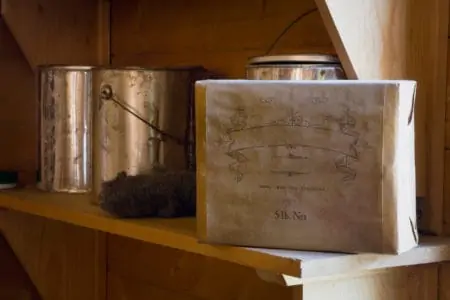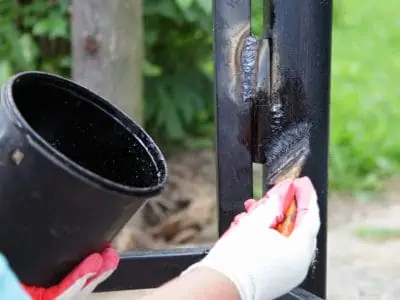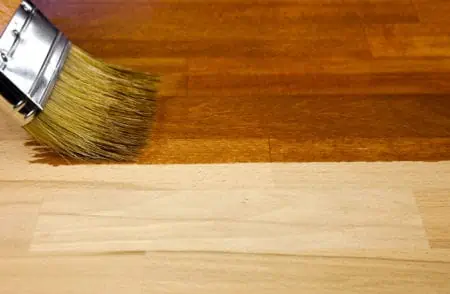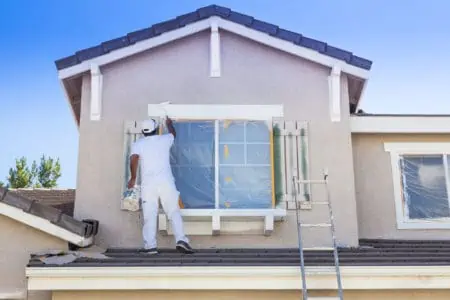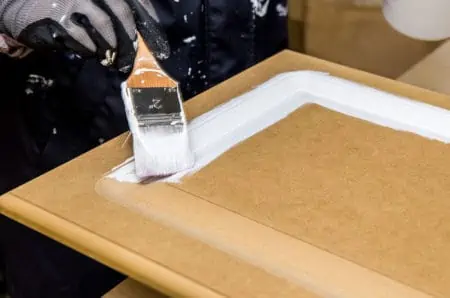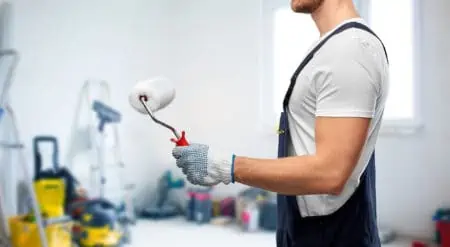That half-empty can of paint gathering dust on your garage shelf has probably been there for some time. When you eventually start a new project, it’s time to crack open the lid, but exactly how long does paint last? Is it still usable, or does paint expire?
We explore the shelf-life of paint and answer the question, “can paint go bad?”
Key Takeaways
- All paint goes bad eventually, but the lifespan varies depending on the type of paint and storage conditions.
- Signs of bad paint include a bulging can, rancid or sour smell, lumpy texture, and a gloopy consistency.
- Revive old paint by adding water for latex or acrylic paint, or using thinners and solvents for oil-based paint, and stirring vigorously.
- Store paint properly by keeping it cool and dry, decanting it into a plastic container, using kitchen wrap for an airtight seal, and avoiding freezing temperatures.
Does Paint Go Bad?
All paint goes bad, but the timescale of when it becomes unusable varies depending on the type of paint and how you store it. Latex paint, if left sealed, will last for a decade, but that same paint might only last for months if it is poorly kept.
Air and moisture are drivers to turn your leftover paint bad. Microorganisms eat the contents, causing it to give off gas, which then bulges the can. If the can is misshaped, it could signify that the paint is on the turn.
Repeated freezing and thawing will cause your paint to break down, so how you store it matters. Garages are cold spaces, so the old paint on your shelves is likely to experience plummeting temperatures.
Dangers of Using Old Paint
Your old paint has been exposed to air, moisture, and temperature fluctuations, which change the chemical makeup of the contents. Using it on your walls and ceilings will release odors that could harm your health.
When you remove the lid, if you get a foul or sour smell, it is a sure-fire bet that the paint has gone bad. When you paint it on your walls, the smell diminishes but still lingers.
How Long Does Unopened Paint Last?
We need to look at each paint type individually to answer that question, because lifespans vary enormously. The good news is that almost all paint has a long shelf-life if left unopened. So if you’re panicking that you bought it a month ago and you haven’t used it, relax!
Acrylic or Latex Paint
Paint manufacturers are deliberately cautious when they give paint use-by dates. Most will tell you they last for two years when left sealed in the tin. However, it’s not unknown for some latex and acrylic paint to last up to 10 years when stored correctly and if unopened.
Oil-Based Paint
Oil-based paints contain solvents that last longer than water-based products. For this reason, the lifespan of an unopened oil-based paint is upwards of 15 years.
Chalk Paint
Famous chalk paint manufacturer Annie Sloane estimates that chalk paint will last for one year, but that may be on the cautious side. They also concede that chalk paint could last for several years.
Chalk paint is water-based, so even if it separates in the can or thickens over time, it can be brought back to usable condition by adding water.
Milk Paint
Milk paint comes in liquid form or as a powder. Wet milk paint will only last a matter of days because the milk in the formula goes off. If refrigerated, you could extend the usable life by a week. In powder form, it will last indefinitely as long as you keep it away from moisture.
| Paint Type | Lifespan |
| Acrylic or latex paint | 2 to 10 years |
| Oil-based paint | 2 to 15 years |
| Chalk paint | 1 to 5 years |
| Milk paint | 1 to 7 days |
How Do You Know If Paint Is Bad?
There are several ways to tell if your paint has gone bad. Knowing the signs is crucial because you wouldn’t want to coat your interior walls with expired paint only to have to redo it later down the line.
1. Can Is Bulging
A clear sign your paint has turned is a bulging can. When the paint is incorrectly stored, microorganisms and bacteria get in and start to eat the paint. This causes gas to escape, creating pressure inside the can. As the pressure builds, the can warps and bulges.
2. Rancid or Sour Smell
If you get a strong odor, it’s time to trust your nose and discard the paint. Rancid, sharp or sour odors are all signs that your paint is bad. Even if you used it on your interior walls, while the smell might diminish slightly, it would still linger.
3. Frozen and Then Thawed
Garages and workshops are often uninsulated, and they are also the most common places to store unused paint. If the paint is repeatedly exposed to extreme cold, the formula breaks down.
Interesting Point
Some industry experts say that you can successfully freeze and thaw paint once, and it will be perfectly usable. Note, however, that repeated exposure will cause problems.
4. Lumpy Paint
It is usual for latex paints to develop a thick skin on the surface of the paint. The skin peels away, and the paint is perfectly usable. However, if the paint is still lumpy after you have stirred it, it has gone bad.
5. Gloopy Consistency
Your paint is bad if it feels jelly-like and gloopy. It is somewhere between liquid and solid and is unusable.
If it feels like the consistency is too thick throughout, it is time to get a new can of paint.
How Do You Make Paint Usable Again?
Bringing your paint back to life means you can still use it to paint the walls inside your house, saving you spending more money buying a replacement can of paint. We give you some hints and tips to help you use that old paint.
Just Add Water
If your paint is latex or acrylic, water is the main ingredient. Sometimes reviving old acrylic paint is as simple as adding more water to loosen the thickened formula. Remove the thick skin that sits on the top, pour in the water, and mix vigorously.
The secret is to not pour in too much water to make the paint thin. Add it in stages and mix thoroughly before adding more.
Thinner, Solvent, and Mineral Spirits
Oil-based paint can be revived using oil-based solutions like thinners, rubbing alcohol, or mineral spirits. Add in the solvent, stir thoroughly, and check the consistency.
As with water-based paint, don’t make the formula too thin by adding too much thinner. Try adding it in small stages and stirring to check the consistency.
Vigorous Stirring
Sometimes the best solution is to grab a sturdy stick and mix the paint for two or three minutes until the pigments distribute evenly. If the paint feels lumpy, it might be better to concede defeat and get new paint, but if it mixes smoothly, it is still usable.
Shaken Not Stirred
Paint in a can settles and separates over time. The easiest way to revive the contents of your unopened can is to take it to the DIY store and get them to use their paint shaking machine to loosen the contents.
This will not work with paint if opened because the contents are not secure once the seal is broken.
How To Store Paint Properly
Once the paint is open, any leftover paint needs to be stored in the right conditions to preserve its usability. Simply placing it on a shelf and forgetting about it won’t keep it fresh for long and will result in you buying more paint.
Keep It Cool and Dry
Paint should be stored in dry conditions and kept out of direct sunlight. Moisture reacts with the paint and allows bacteria to grow, which eats the contents. This then releases gas as the paint turns bad.
Humidity also reacts with the metal can, causing it to rust and become contaminated.
Decant The Paint
Storing paint in a can may not be the best way to keep the paint from going bad. If the can gets dented or rusts, small flecks of metal pollute the paint formula, causing a chemical reaction. Find a sturdy plastic container and pour the paint in, ensuring the lid fits tightly and no air can get in.
Use Kitchen Wrap
If you are storing your paint in the tin, stretch a sheet of kitchen wrap over the open can before closing the lid and then tap the top down using a mallet for a tight seal. The kitchen wrap acts as a barrier between the metal lid and helps to create an airtight seal.
Don’t Let it Freeze
Avoid freezing temperatures when storing paint. After it freezes and thaws multiple times, it starts to break down. This is especially important if you live in an area where the climate is colder, but not such an issue in states like California.
FAQs
It’s All About Storage
Does paint go bad? Yes, but if you are serious about reusing an old leftover color, you have to store it properly. Keep it cool, out of direct sunlight, and ensure the lid is securely sealed so no air can get in.
Once you follow these rules, you can ensure that your unused paint stays fresh for a long time. It’s certainly a lot cheaper than buying fresh new paint, especially if all you want is a small amount for touching up scuffs and stains.
